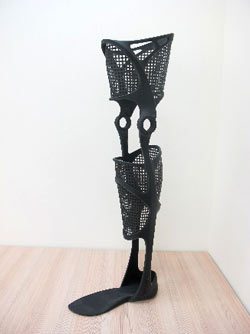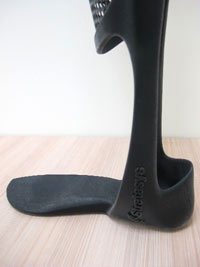Stratasys 3D Printing: Customized, Cost-Effective, Lightweight Leg Brace
Stratasys 3D Printing: Lightweight Leg Brace is Cost-Effective and a Perfect Fit

3D printed on an Objet1000 Multi-material 3D Production System, the KAFO Splint is a customized, airy, and fashionable design for a functional leg brace.
Braces or splints are a part of life for many who have experienced serious illness or injury. Widely used to support limbs which cannot take a person’s full weight, the design of braces seems to be in desperate need of a makeover. Or Steiner, an industrial designer, applied his training and experience – and used Stratasys 3D printing to modernize the old-fashioned appearance of leg braces as his graduation project.
Steiner is an alumnus of the Shenkar College of Engineering and Design (another recent Shenkar graduate, Noa Raviv, made a splash with her senior project, a fashion collection with 3D printed elements). During his studies, Steiner gained experience with 3D printing technology while making models for product designs.
From Bulky to Beautiful
Steiner’s foray into this aspect of medical device design came after he was in touch with Ron who had been in an accident eight years before, leaving him dependent on a wheelchair or braces in combination with crutches. But the braces were heavy and ungainly, a combination that meant that he did not want to wear them at all. Steiner’s vision for the redesign was to create personalized braces that were practical but also fashionable, so that those who had to wear them would also want to wear them.
The new design for the braces, which Steiner calls the “KAFO Splint,” is an airy, 3D printed version of the original. There is enough solid material for the crucial stabilization, but the openness allows for airflow and lightness that traditional braces lack. Adding 3D scanning technology to Steiner’s design enables every KAFO Splint to be adapted to each patient’s body.
Always a Perfect Fit

Stratasys Rigid opaque black 3D printing material (VeroBlack) provides the weight-bearing support required by the KAFO Splint.
“The main advantages are that it is customized and personalized to the user,” Steiner told the Stratasys Blog. “The 3D print can look like a regular product that was created using injection molding, but it’s actually custom made. The design possibilities are great, and the finished product can be very attractive.”
Steiner used an Objet1000 Multi-material 3D Production System to create the final product, leveraging VeroBlack, a rigid opaque PolyJet 3D printing material. After months of trial sketches and designs, the final KAFO Splint was 3D printed, as he explained “…in one piece!” Despite the full “leg” extension of the design, the entire 3D print was easily accommodated in the one-meter build tray of the Objet1000.

 Blog
Blog